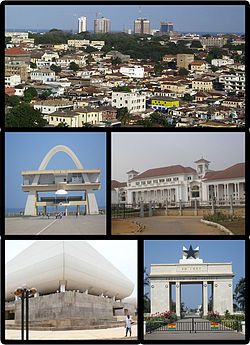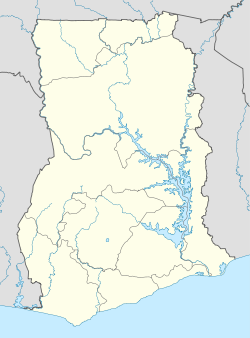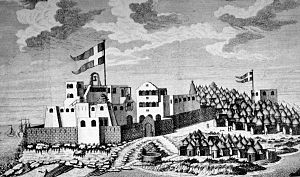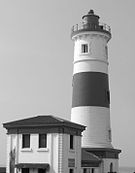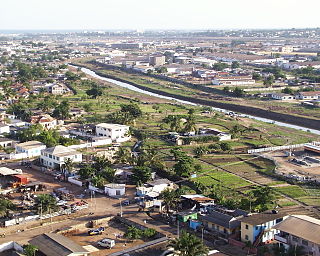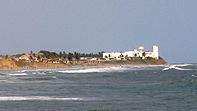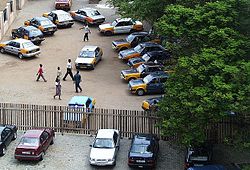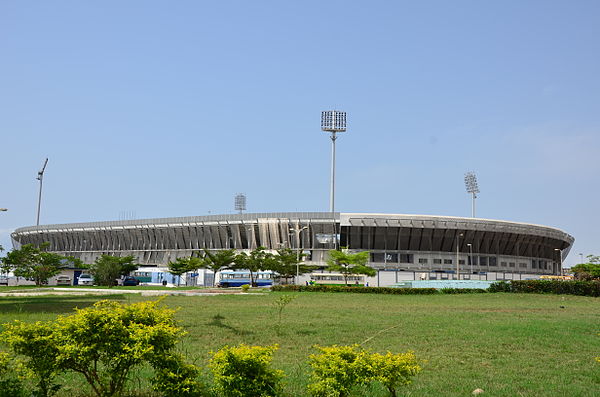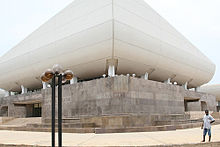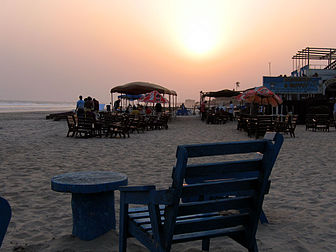
Accra
Did you know...
This Schools selection was originally chosen by SOS Children for schools in the developing world without internet access. It is available as a intranet download. SOS Children has looked after children in Africa for forty years. Can you help their work in Africa?
| Accra | |||
|---|---|---|---|
| — City, District Capital & Regional Capital — | |||
| Clockwise from top: skyline of the city, the Supreme Court of Ghana, Independence Square, the National Theatre and the Independence Arch. | |||
|
|||
|
|
|||
| Coordinates: 5°33′00″N 0°12′00″W Coordinates: 5°33′00″N 0°12′00″W | |||
| Country | |||
| Region | Greater Accra Region | ||
| District | Accra Metropolitan District | ||
| Settled | 15th century | ||
| Incorporated (city) | 1898 | ||
| Government | |||
| • Type | Mayor–council | ||
| • Mayor | Alfred Vanderpuije | ||
| Area | |||
| • City, District Capital & Regional Capital | 173 km2 (67 sq mi) | ||
| • Metro | 894 km2 (345.18 sq mi) | ||
| Elevation | 61 m (200 ft) | ||
| Population (2012) | |||
| • City, District Capital & Regional Capital | 2,291,352 | ||
| • Density | 9,589.2/km2 (24,836/sq mi) | ||
| • Demonym | Accran | ||
| Ranked 1st in Ghana | |||
| Time zone | UTC | ||
| Area code(s) | 030 | ||
| Website | http://www.ama.gov.gh | ||
Accra / ə ˈ k r ɑː / is the capital and largest city of Ghana, with an estimated urban population of 2,291,352 as of 2012. Accra is also the capital of the Greater Accra Region and of the Accra Metropolitan District, with which it is coterminous. Accra is furthermore the anchor of a larger metropolitan area, the Greater Accra Metropolitan Area (GAMA), which is home to about 4 million people, making it the largest metropolitan conglomeration in Ghana by population, and the eleventh-largest metropolitan area in Africa.
Accra stretches along the Ghanaian Atlantic coast and extends north into the country's interior. Originally built around a port, it served as the capital of the British-ruled Gold Coast between 1877 and 1957. Once merely a 19th-century suburb of Victoriaborg, Accra has since transitioned into a modern metropolis; the city's architecture reflects this history, ranging from 19th-century British colonial buildings to modern skyscrapers and apartment blocks.
Accra is Ghana's primate city, serving as the nation's economic and administrative hub. It is furthermore a centre of culture and tourism, sporting a wide range of nightclubs, restaurants and hotels. Since the early 1990s, a number of new buildings have been built, including the multi-storey French-owned Novotel hotel. The city's National Theatre was built with Chinese assistance. In 2010, the GaWC designated Accra a Gamma-minus-level world city, indicating a growing level of international influence and connectedness.
The central business district of Accra contains the city's main banks and department stores, the Cocoa Marketing Board headquarters (dealing with cocoa, Ghana's chief export), and an area known as the Ministries, where Ghana's government administration is concentrated. Economic activities in Accra include the financial and agricultural sectors, Atlantic fishing, and the manufacture of processed food, lumber, plywood, textiles, clothing and chemicals.
History
The word Accra is believed to be derived from the Akan word nkran, meaning "ants", a reference to the numerous anthills seen in the countryside around Accra. The city was first settled in the 15th century, when the Ga people migrated there from their previous settlement at Ayawaso, 10 miles (16 km) north of Accra. The site was advantageous due to its distance from the Ga's main rivals, the Akwamu people. Initially, Accra was not the most prominent trading centre; the trade hubs of the time were the ports at Ada and Prampram, along with the inland centres of Dodowa and Akusa. However, Accra gained status as a centre for the slave trade with the Europeans who had built the nearby outposts of James Fort and Ussher Fort. By the 17th century, the Portuguese, followed by the Swedish, Dutch, French, British and Danish, had constructed forts in the town. Such activity went on in Accra until the abolition of the slave trade in 1807.
In the 1850s, Denmark sold Christiansborg and their other forts to the British. In 1873, after decades of tension between the British and the Asante people of central Ghana, the British attacked and virtually destroyed the Asante capital of Kumasi, and officially declared Ghana a crown colony. The British then captured Accra in 1874, and in 1877, at the end of the second Anglo-Asante War, Accra replaced Cape Coast as the capital of the British Gold Coast colony. This decision was made because Accra had a drier climate relative to Cape Coast, and was not home to the tsetse fly, thus allowing the use of animal transport. Until this time, the settlement of Accra was confined between Ussher Fort to the east and the Korle Lagoon to the west.
As the colony's administrative functions were moved to Accra, an influx of British colonists began, and the city began to expand to accommodate the new residents. Victoriaborg was formed in the late nineteenth century as an exclusive European residential neighbourhood, located to the east of the city limits of the time. The boundaries of Accra were further stretched in 1908, following an outbreak of the bubonic plague. This expansion entailed the creation of a native-only neighbourhood, intended to accommodate members of the native population as a means of relieving congestion problems in the overcrowded city centre. Adabraka was thus established to the north of the city centre to serve as an enclave for the town's Muslim population.
One of the most influential decisions in the history of the city was that of building the Accra-Kumasi railway in 1908. This was to connect Accra, the country's foremost port at that time, with Ghana's main cocoa-producing regions. In 1923 the railway was completed, and by 1924 cocoa was Ghana's largest export. Accra was the main exporter of cocoa until 1928; this was one of the main reasons for its rapid growth.
The British government heavily influenced the shape that Accra took during this period. For example, racial segregation of neighborhoods was mandated by law until 1923, and all new buildings were required to be built out of stone or concrete. Despite these regulations, the British government was very hesitant to invest any large amount of money into the city to maintain its infrastructure or improve public works. This did not change until the governorship of Sir Frederick Gordon Guggisberg.
Among the achievements of Guggisberg was the building of a bridge across the Korle Lagoon in 1923, which opened the land west of the lagoon for settlement. Guggisberg also oversaw the building of hospitals and schools. Such improvements led to an increase in Accra’s population due to the migration of rural dwellers into the city, and the immigration of increasing numbers of British businessmen and administrators.
Post-World War II
In the years following World War II, the neighbourhoods of Ridge and Cantonments were planned as low-density developments for Europeans, while many rural migrants settled in neighbourhoods which had not yet been incorporated into Accra's municipal boundary, such as Nima or Accra New Town. Thus, the development of these neighbourhoods was unregulated by the government, creating a crowded and jumbled shanty-town landscape.
Another area of Accra that took shape at this time was the central business district (CBD). More administrative buildings were built on High Street, forming a massive judicial/administrative complex. Additionally, the expansion of the economy led to many more commercial buildings being built in the CBD.
In 1944, Accra's city planner Maxwell Fry devised a town plan, which was revised in 1958 by B.D.W. Treavallion and Alan Flood. Although the Fry/Trevallion plan was never followed through, it illustrated the British vision of how Accra should develop.
Fry/Treavallion Plan
In the Fry/Treavallion plan, a reorganisation of the CBD was called for, as well as the development of the coastal region of the city. In order to reorganise the CBD, the planners decided to superimpose a tight street grid north of Fort Ussher.
To the east of this newly organised CBD, the planners hoped to preserve a broad open space for a restaurant, country club, and polo and cricket fields. Additionally, the British planners intended to build large numbers of public squares, fountains and ornamental pools and statues throughout the city, as well as a vast Parliament Complex in the city centre. Lastly, the Fry/Treavallion plan included plans to make the coastal region an extension of the exclusive European neighbourhood of Victoriaborg, and to create a recreational preserve for the elite. However, the British colonial rule in Ghana ended before the Fry/Treavallion plan was enacted.
Nkrumah Plan
When Kwame Nkrumah became Ghana's first post-independence Prime Minister in 1957, he created his own plan for Accra's development. Instead of creating spaces to serve the elite, Nkrumah sought to create spaces to inspire pride and nationalism in his people and people throughout Africa.
Rather than creating ornamental fountains and a large Parliament complex, Nkrumah decided to build landmarks such as Independence Square, the State House, and the Organisation of African Unity building, and to refurbish Christianborg Castle. Nkrumah decided to leave the Atlantic coastal region undeveloped, so as to not detract attention away from the Community Centre or Independence Square, lending both spaces symbolic significance. The Nkrumah plan did not emphasize order nearly as much as the Fry/Treavallion plan did; whereas the British plan strove to lessen crowding in the commercial district and help relieve the overcrowding of neighbourhoods bordering the CBD, the Nkrumah plan allowed for continued compression of commercial establishments into the CBD, as well as increased migration into Jamestown.
Present-day Accra
The modern city is centred around the original Ga town, as well as the British, Danish and Dutch forts and their surrounding communities: Jamestown near the British James Fort, Osu near the Danish fort of Christiansborg (now Osu Castle), and Ussherstown near the Dutch Ussher fort.
Today, Accra has several major tourist attractions, including the National Museum of Ghana, the Ghana Academy of Arts and Sciences, the National Archives of Ghana and Ghana's central library, the National Theatre, the Accra Centre for National Culture, a lighthouse, and the National Sports Stadium.
The city is also a major transportation hub, home to the Kotoka International Airport and railway links to Tema, Takoradi and Kumasi. Accra has furthermore become a popular location for national and international business conferences.
Accommodation in Ghana
Geography

Central Accra is compact, centered around the historical British, Danish, and Dutch forts. Over the years, however, with immigration from rural areas, the city has expanded with no regard to zoning, giving it a sprawled attribute. The city of Accra has a total area of 200 square kilometres (77 sq mi), and is the anchor city of the Greater Accra Metropolitan Area (GAMA), which is made up of the Accra Metropolitan District, Tema Metropolitan District, Ga South Municipal District, Ga East Municipal District, Ga West Municipal District, Adenta Municipal District, Ashaiman Municipal District, Ledzokuku-Krowor Municipal District, and the town of Kasoa in the Awutu Senya District of the Central Region.
The intersection of the Lafa stream and Mallam junction serves as the western border of the city. The Great Hall of the University of Ghana forms Accra's northern border, while the Nautical College forms the eastern border. The Gulf of Guinea forms the southern border. These borders notwithstanding, points of conflict with adjoining districts exist, resulting in a de facto shrinking of the city limits in recent years.
Neighbourhoods

The growth of Accra in recent decades due to immigration from the Diaspora of the Americas, European, Asian, including African nationals and other nationals from all over the world, has outstripped the provision of services such as waste collection, potable water and electricity. Because of immigration there has been a rise of large slums. Accra currently has 9 slums. All nine Slums settlements, and the so-called " Sodom and Gomorrah" shanty towns, are being demolished because of their negative effect on the environment.
Accra Central
The Ring Road, extending from the Korle Lagoon in the west, north to Kwame Nkrumah Circle, following east to the juncture of Independence Avenue, and continuing on to Osu, forms a ring around the oldest districts of Accra, and separates central Accra from the outlying suburbs.
Central Accra includes the CBD, which consists of the historic districts of Usshertown, Tudu, Victoriaborg, West Ridge, and East Ridge, as well as the historic residential districts of Jamestown, Adabraka, Asylum Down, North Ridge and Christiansborg/Osu.
Although satellite business districts such as the Airport City have been established across the city, Central Accra remains the administrative and cultural centre of Accra, hosting the nation's government ministries, hotels and businesses, along with the headquarters of many of Ghana's major financial institutions.
Central Accra's principal attractions include the Kwame Nkrumah Mausoleum, the National Museum, Independence Square, the National Theatre, and the Ohene Djan Stadium.
Accra North
Northern Accra is a major residential and business district. The area also contains important landmarks such as the "37" Military Hospital, Golden Jubilee House, several important foreign embassies, Achimota School, Achimota Golf Park, and the University of Ghana's Legon campus, which serves as the city's northern boundary.
Geographically, for the purposes of this article, the areas north of Ring Road West and Central, east of Winneba/Graphic Road, and west of Liberation Road will be regarded as Northern Accra. The districts just north and south of the Kwame Nkrumah motorway will also be included in this classification.
Accra East
Eastern Accra is largely residential, and geographically north of Ring Road East, stretching as far north as Kwame Nkrumah Motorway; the district is bordered to the west by Liberation Road.
Accra West
Western Accra is largely a residential and business area. Whilst geographically less expansive than the northern and eastern reaches of the city as a result of the large saltponds of Tettegu and Aplaku, it nonetheless boasts one of Accra's most important landmarks, the Korle Bu Teaching Hospital.
Geographically, the areas west of Ring Road West, extending as far west as the saltponds and south of Graphic Road, are considered Accra West.
Climate
Owing to its location in the Dahomey Gap, where the coast runs parallel to the prevailing moist monsoonal winds, Accra features a tropical savanna climate that borders on a semi-arid climate. The average annual rainfall is about 730 mm, which falls primarily during Ghana's two rainy seasons. The chief rainy season begins in April and ends in mid-July, whilst a weaker second rainy season occurs in October. Rain usually falls in short intensive storms and give rise to local flooding where drainage channels are obstructed.
There is very little variation in temperature throughout the year. The mean monthly temperature ranges from 24.7 °C (76.5 °F) in August (the coolest) to 28 °C (82.4 °F) in March (the hottest), with an annual average of 26.8 °C (80.2 °F). It should be noted, however, that the "cooler" months tend to be more humid than the warmer months. As a result, during the warmer months and particularly during the windy harmattan season, the city experiences a breezy "dry heat" that feels less warm than the "cooler" but more humid rainy season.
As Accra is close to the equator, the daylight hours are practically uniform during the year. Relative humidity is generally high, varying from 65% in the mid-afternoon to 95% at night. The predominant wind direction in Accra is from the WSW to NNE sectors. Wind speeds normally range between 8 to 16 km/h. High wind gusts occur with thunderstorms, which generally pass in squall along the coast.
The maximum wind speed record in Accra is 107.4 km/h (58 knots). Strong winds associated with thunderstorm activity often cause damage to property by removing roofing material. Several areas of Accra experience micro-climatic effects. Low-profile drainage basins with a north-south orientation are not as well ventilated as those orientated east-west.
Air is often trapped in pockets over the city, and an insulation effect can give rise to a local increase in air temperature of several degrees. This occurs most notably in the Accra Newtown sports complex areas.
| Climate data for Accra | |||||||||||||
|---|---|---|---|---|---|---|---|---|---|---|---|---|---|
| Month | Jan | Feb | Mar | Apr | May | Jun | Jul | Aug | Sep | Oct | Nov | Dec | Year |
| Record high °C (°F) | 34 (93) |
38 (100) |
38 (100) |
34 (93) |
35 (95) |
33 (91) |
32 (90) |
32 (90) |
32 (90) |
32 (90) |
33 (91) |
34 (93) |
38 (100) |
| Average high °C (°F) | 31 (88) |
31 (88) |
31 (88) |
31 (88) |
31 (88) |
29 (84) |
27 (81) |
27 (81) |
27 (81) |
29 (84) |
31 (88) |
31 (88) |
30 (86) |
| Average low °C (°F) | 23 (73) |
24 (75) |
24 (75) |
24 (75) |
24 (75) |
23 (73) |
23 (73) |
22 (72) |
23 (73) |
23 (73) |
24 (75) |
24 (75) |
23 (73) |
| Record low °C (°F) | 15 (59) |
17 (63) |
20 (68) |
19 (66) |
21 (70) |
20 (68) |
19 (66) |
18 (64) |
20 (68) |
19 (66) |
21 (70) |
17 (63) |
15 (59) |
| Rainfall mm (inches) | 15 (0.59) |
33 (1.3) |
56 (2.2) |
81 (3.19) |
142 (5.59) |
178 (7.01) |
46 (1.81) |
15 (0.59) |
36 (1.42) |
64 (2.52) |
36 (1.42) |
23 (0.91) |
725 (28.54) |
| Avg. rainy days | 1 | 2 | 4 | 6 | 9 | 10 | 4 | 3 | 4 | 6 | 3 | 2 | 54 |
| Mean monthly sunshine hours | 217 | 226 | 217 | 210 | 217 | 150 | 155 | 155 | 180 | 217 | 240 | 248 | 2,432 |
| Source: BBC Weather | |||||||||||||
Demographics
With an estimated population of about 3.9 million, Accra is today one of the largest and fastest-growing cities in Africa, with an annual growth rate of 3.36%.
The period between 1960 and 1970 saw rapid industrialisation and expansion in Accra's manufacturing and commercial sectors. This contributed to high rural-urban migration from west African nationals to the city, and consequently a high population growth rate.
The stagnation of the Ghanaian economy during the 1970s slowed the growth of Accra’s population, as shown by the falling growth rate of the 1970-1984 intercensal years. Later, however, the decline in agriculture in rural communities in Ghana and rising industrialisation in urban regions, coupled with the late-1980s boom in the service sector, once again propelled immigration to Accra.
The primacy of the Accra Metropolitan Area as Ghana's administrative, educational, industrial and commercial centre continues to be the major force for its rapid population growth, with immigration contributing to over 35% of the city's population growth.
Distribution and density
The gross density of population for the Accra Metropolitan Area in 2000 was 10.03 persons per hectare, compared to 6.23 per hectare in 1970. The highest densities were recorded in the Accra Metropolitan Assembly, with an overall average of 69.3 persons per hectare.
At the community level, densities exceeding 250 persons per hectare occurred mostly in the immigrant and depressed areas in the oldest parts of Accra, such as Accra New Town, Nima, James Town and Ussher Town. In higher-income areas, densities ranged between 17.5 and 40 persons per hectare.
Population distribution by age and gender
Accra’s population is a very youthful one, with 56% of the population being under 24 years of age. This predominance of young people is not expected to decline in the foreseeable future. Fifty-one percent (51%) of the population are females, and the remaining 49% males. This gives a males-to-females ratio of 1:1.04. The greater number of females is a reflection of the nationwide trend, where the estimated ratio of males to females is 1:1.03.
Migration
Decentralisation, and birth control policies are expected to reduce both the natural birth and migration rates in Accra. However, the city's infrastructure and economic growth will for a long time make it a more attractive place for public servants and national and international investors.
An assessment of the extent of migration to Accra, based on present locality and sex, reveals that 44% of residents in Accra are west African migrants from neighbouring countries. This reflects the cosmopolitan nature attractiveness of the metropolis.
Housing characteristics
Parts of inner-city Accra comprise a mixture of very low-density development with under-utilised service infrastructure on the one hand, and indigenous, low-class, and high-density development with depressed conditions and overstretched infrastructure services on the other.
The rapid growth of Accra has led to the neglect of some of the old indigenous settlements, whilst efforts are being made to provide the newly developing suburban areas with services and infrastructure to cater for the needs of the middle-income earners mostly found there.
The result is that the older indigenous areas of Accra, such as Ga Mashie, are experiencing decay. Calls are being made for proactive efforts of inner city revitalisation to address this issue.
Peripheral residential development in Accra is usually haphazard, with barely sufficient infrastructure to support it. There are also large numbers of uncompleted houses, interspersed with pockets of undeveloped land, which are often subject of litigation, due to the inability of organisations and individuals who own them to complete or develop them due to lack of funds.
Housing can be grouped into three broad categories: the low-income, middle-income and high-income areas. The low-income housing zones may be divided into indigenous and non-indigenous (dominantly immigrant) areas. The low-income indigenous housing areas comprise Osu, Jamestown, Adedenkpo, Chorkor, La, Teshie and Nungua.
The low-income non-indigenous housing areas include Sukura, Kwashieman, Odorkor, Bubiashie, Abeka, Nima, Maamobi and Chorkor. Altogether, these areas accommodate about 58% of Accra’s total population of which are the west African. Most of the city's informal businesses are located in low-income areas, which are the first place of abode for any new job-seeking immigrant.
Housing conditions
Almost all low-income areas are built up with little room for expansion. This is particularly so in the indigenous areas of the inner city. Conditions are generally depressed, with poor supporting social and engineering infrastructure.
Buildings are of poor-quality material, often using mud, untreated timber and zinc roofing sheets for walling. The housing environment is characterised by haphazard development, inadequate housing infrastructure, poor drainage.
The middle-income areas of Accra are predominantly populated by Ghanaian citizens, Lebanese, European, and Asian business, administrative and professional families. Much of the housing in these areas has been provided by state, parastatal and private sector organisations and individuals.
The middle-income areas include Dansoman Estates, North Kaneshie Estates, Asylum Down, Kanda Estates, Abelempke, Achimota and Tesano. Usually, these areas, unlike the low-income areas, are planned developments, but are in need of infrastructure services. Building materials and general housing conditions are of better quality. The middle-income group comprises 32% of the city's population of which are Ghanaian citizens, Lebanese, Europeans, and Asians make up.
The high-income areas provide housing for the remaining 10% of the population of which Ghanaian citizens, Lebanese, Europeans, and Asians also make up. They include areas like North and West Ridge, Ringway Estates, north Labone Estates, Airport Residential Area, Roman Ridge, East Legon. These areas are all planned and have well developed infrastructure with spacious and landscaped ground in sharp contrast with, particularly, the low-income areas. Buildings are usually built with sandcrete blocks, and have walls and roofed with aluminium, or asbestos roofing sheets.
There are also high-income peripheral areas like Haatso, Kwabenya, Pokuase, Adenta, Taifa, Mallam, where development of engineering infrastructure is not yet complete. These areas developed ahead of infrastructure, however the Achimota-Ofankor motorway is scheduled to open in May 2012, and the Awoshie-Pokuase dual carriageway is now under construction. Building materials used are similar to those in the middle and high-income zones.
In total, 84.4% of all houses in the Accra Metropolitan Area have their outside walls made up of cement, as compared to 63.3% for other Ghanaian urban areas, and 44.8% for the nation in general. Similarly, houses found within Accra have 99.2% of their floor materials made up of cement, while the figures for other urban areas and the nation are 95.1% and 84.7% respectively. It can therefore be inferred that, although in some instances low-income areas have exhibited poor housing conditions, the general quality of housing in Accra is significantly better than that of other urban areas and Ghanaian housing in general.
Government
Accra has a mayoral council government system in which the mayor is vested with extensive executive powers. The mayor is appointed by the President of the Republic of Ghana and approved by the city council, although the public has expressed a desire to increase mayoral accountability by holding free mayoral elections. The current mayor of Accra is Alfred Vanderpuije, appointed by President John Atta Mills in 2009.
The Accra Assembly has a total of 104 members. Of these, 70% are elected and 30% are government appointees. The Town and Country Planning Department is responsible for land-use planning in the metropolis.
As the capital of Ghana, Accra is the home of the national administration, including the Ministries and Parliament. Accra also serves as the home of the Supreme Court of Ghana, and is the headquarters of the Bank of Ghana.
Due to its size, Accra is divided into 11 sub-metropolitan areas:
- Ablekuma Central
- Ablekuma North
- Ablekuma South
- Ashiedu Keteke
- Ayawaso Central
- Ayawaso East
- Ayawaso West Wuogon
- La
- Okaikoi North
- Okaikoi South
- Osu Klottey
Economy
In 2008, the World Bank estimated that Accra's economy constituted around 10% of Ghana's total gross domestic product (GDP), or around US$3 billion. The economically active population of Accra is estimated to be 823,327, but the daily influx of commuters from dormitory towns outside the city inflates this figure on most days.
Accra is a major centre for manufacturing, marketing, finance, insurance, transportation and tourism. It has around 350 major industrial establishments, with Lebanese and Asian companies predominant in business and the economy. Its financial sector incorporates a central bank, nine commercial banks (with 81 branches), four development banks (with 19 branches), four merchant banks (with seven branches), three discount houses, one home finance mortgage bank, multiple building societies, Ghana Stock Exchange (GSE) and GSE All-Share Index, 218 foreign exchange bureaux, nine finance houses, nine insurance companies, 12 insurance brokerage firms, two savings and loans companies, and numerous real estate developers. Lebanese, European and Asian companies predominantly own land in the capital, with significant industrial sites and residential developments. They also dominate the importation of goods and services.
The road network in the Accra Metropolitan Area totals 1,117 kilometres (694 mi) in length, consisting of 918 kilometres (570 mi) of paved and 199 kilometres (124 mi) of unpaved roads.
There are over 50,506 identified residential properties in Accra, and about 4,054 commercial/industrial/mixed properties, with a total rateable value of GH¢13,849,014. There are also 29 markets, 36 facilities for both on–street and off-street parking, and over 120,000 units of wholesale, retail and other self-employed businesses, as well as several facilities for sports and recreation, and many tourist centres.
Sectors of the economy
The sectors of Accra's economy consist of the primary (farming, fishing, mining and quarrying), secondary (manufacturing, electricity, gas, water, construction) and tertiary sectors (wholesale trade, retail trade, hotel, restaurant, transportation, storage, communication, financial intermediation, real estate service, public administration, education, health and other social services). The tertiary service sector is the city's largest, employing about 531,670 people. The second-largest, the secondary sector, employs 22.34% of the labor force, or around 183,934 people. 12.2% of the city's workforce are reportedly unemployed, totalling around 114,198 people.
Primary sector
Accra's smallest economic sector, the primary sector, employs approximately 91,556 people. The predominant economic activities are fishing and urban agriculture, with fishing accounting for 77.8% of production labour.
Farming is practised mostly by families, often without the benefits of modern methods of production. Farming in Accra centres around the growth of vegetables such as okro, garden eggs, tomatoes, carrots, cucumbers, cabbage, cauliflower, and lettuce. The volume of production of these crops is negligible and declining. The increasing land value in Accra is resulting in urban agricultural land being converted to commercial and economic purposes.
Poultry production is constrained by the high cost of feed. The metropolis has a number of domestic animals, mostly sheep and goats, which depend on the area's natural vegetation for feed. However, large quantities of meat and various dairy products are imported from neighbouring countries and abroad to supplement local production.
The fishing industry is the most important sub-sector, with 10% of the catch being exported and the rest consumed locally. The main types of fish caught include redfish, red bullet, herring, sardines, tuna, yellowfish and grouper. There are also significant quantities of shrimp, lobsters and sole caught. The industry is characterized by extreme seasonableness, operating primarily between June and September, especially in the case of herring and sardine fishing. As a result of Accra's lack of modern refrigerate storage facilities, prices tend to drop during the peak fishing season, resulting in the under-utilization of fishing resources. The bulk of the marine catch during the fishing season is caught by small canoe fishermen, who have little or no link with credit institutions to support the expansion of their businesses.
Although most deep-water Atlantic fishing around Accra takes place in the June–September period, fishing operations take place close to the shore throughout the year, and there are clear indications of the depletion of fish stocks in the near future. Fishing operations are most prominent at the Jamestown, La, Teshie, Nungua and Chorkor fishing shores.
Education
Pre-school
Pre-school comprises nursery and kindergarten. In 2001, there was 7,923 children (3,893 girls and 4,030 boys) in pre-schools in Accra. In 2010, the enrollment rate at Pre-school was 98%. Pre-schools are regulated by the Ministry of Employment and Social Welfare, and are mostly privately owned and operated. In 2001, there were 62 government-owned pre-schools in the Accra metropolis.
Primary school
Primary school enrollment of girls is higher than that of boys. In 2010, the enrollment rate at primary school level was 95%.
Junior high school (JHS)
The Junior High School is part of Ghana's basic education program. Its nationwide implementation began on 29 September 1987.
In the 2001/2002 academic year, 61,080 pupils had enrolled in Accra, representing 57.17% of the 129,467 school-age 12–to-14-year-olds. In 2010, the enrollment rate at Junior high school level was 95%. The ratio of girls is also higher at this level.
Senior high school (SHS)
The transition rate between junior high and senior high school increased from 30 per cent in 1990 to 50 per cent in 2001. The number of students grew by 23,102 between 1990 and 2005, an increase of about 2,310 a year, since 2010 the senior high school enrollment rate has been 95%.
Ghana International School (GIS), a private non-profit A-Level school founded in 1955 for children from ages 3–18, is located in Accra's Cantonments. Abelemkpe is the home of Lincoln Community School, a private, non-profit International Baccalaureate (IB) school for students aged 3–18, established in 1968. The American International School is also situated in Accra.
A number of notable public secondary schools lie on the outskirts of Accra: Achimota Secondary School, commonly referred to as "Motown", which was founded in 1924 and opened in 1927; the Presbyterian Boys' Secondary School, commonly known as "Presec"; Aburi Girls Secondary School, popularly known as "Abugiss" and one of the most well-known girls' boarding schools in Ghana; St Thomas Aquinas Secondary School, commonly known as "Quinas"; the Accra Academy, known as "Accra Aca"; Accra High School commonly known as ("Ahisco");, West Africa Secondary School, commonly known as "WASS"; the Accra Girls' School, commonly known as "Agiss"; Kaneshie Secondary Technical School ("Kateco"); the Armed Forces Secondary Technical; St. John's Grammar School; Action Senior High & Technical School ("Action"); and the City Secondary and Business College ("Cibusco"), among others.
Universities
Ghana's first tertiary education institution, the University of Ghana, is located 13 kilometres (8.1 mi) north of the city centre at Legon. A number of other public and private universities and tertiary institutions have since been founded in Accra, some of which are listed below.
| Institution | Crest | Location | Public/Private | Affiliation |
|---|---|---|---|---|
| University of Ghana (Legon) |
 |
Legon | Public | |
| Regional Maritime University (RMU) |
 |
Nungua | Private | University of Ghana |
| Ghana Telecom University College (GTUC) |
 |
Tesano | Private | |
| Islamic University College (ICUG) | East Legon | Private | University of Ghana | |
| Knutsford University College (Knutsford) | East Legon | Private | University of Ghana | |
| Methodist University College (MUCG) | Dansoman | Private | University of Ghana | |
| Regent University College of Science and Technology (Regent) |
 |
Mataheko | Private | Kwame Nkrumah University of Science and Technology |
| Ashesi University (Ashesi) |
 |
Berekuso | Private | University of Cape Coast |
| Central University College (Central) |
 |
Mataheko | Private | University of Cape Coast |
| Ghana Institute Of Journalism (GIJ) | Rigde | Public | University of Ghana | |
| Accra Polytechnic (A-Poly) | Tudu | Public | ||
| Advanced Business University College (ABUC) | Kaneshie | Private | University of Education, Winneba | |
| Ghana Institute Of Management and Public Administration (GIMPA) | Achimota | Public | ||
| The Institute of Professional Studies (IPS) | Legon | Public | ||
| National Film and Television Institute (NAFTI) | Cantonments | Public | University of Ghana |
Transportation
Accra is served by Kotoka International Airport, which has both civil and military uses. Located 6 miles (9.7 kilometres) from downtown Accra, the airport handles all of the city's scheduled passenger services. Accra is furthermore the hub of two of Ghana's three main railway lines: those to Kumasi and Takoradi.
Downtown Accra's streets were not organised in a grid plan, but rather created as needed. By contrast, the streets of planned housing estates, such as Dansoman Estates, Ringway Estates and Kanda Estates, do follow a grid system.
With Ghana having only 21 passenger automobiles per 1,000 citizens as of 2009, public transportation is the most popular means of getting around Accra. Rail services to Tema, Takoradi and Kumasi are unreliable and unpopular owing to their limited reach.
Metro monorail
Feasibility studies for a $1.5 billion monorail project are to be completed in 2011, to be followed by the construction of rail tracks within the following five years. The privately funded project is to be undertaken by the American Intercontinental Development Corporation (IDC).
Taxis
Accra has an extensive taxi network and numerous taxi ranks, but most taxis lack a meter system, so price negotiation is required between the passenger and driver. Metered taxis do operate in the city, but tend to be more expensive. Taxis in Ghana are painted in two colours: the four bumpers fenders are yellow/orange, and the rest of the car is in a colour of the operator's choice.
Trotros
By far the most common form of transport in Accra, trotros (motor vehicles repurposed for passenger transport) are the biggest, most efficient and cost-effective way of getting around the city. The buses are typically minibuses or vans, with the most popular being Nissan Urvan 15-seaters and Mercedes Benz Sprinter or D 309 vans. Trotros are typically decorated with flags and stickers of various countries or (local and international) soccer teams, and with witty sayings, wisecracks, local proverbs (in English or local languages) or Bible verses printed on the bus's rear. Trotros stop at any bus stop or gathering of people, and can also be found at truck and taxi stations, such as the Neoplan station. The word Trotro may have been derived from the Ga (Gà) word "tro" meaning "pesewa" (the smallest unit of Ghanaian currency), given the trotro's status as a cheap means of transportation.
Buses
In 2003, the Metro Mass Transit Service, was inaugurated in Accra as a more comfortable and cheaper alternative to the trotro. However, the services of these buses have not been highly used. Recently, plans have been afoot to develop a more advanced rapid transit bus system for the city and its metropolitan area. This project is aimed at creating an "integrated, efficient, cost-effective and sustainable transportation system responsive to the needs of society, supporting growth and poverty reduction".
Sport
Football is the most popular sport in Accra, as in the rest of the country. The most famous football club in the city is Accra Hearts of Oak, whose main rivals are Asante Kotoko of Kumasi. The Accra Sports Stadium is home to the Hearts of Oak and the regular pitch of the Black Stars, the national football team. In 2008, the stadium hosted 9 matches in the 2008 African Cup of Nations.
Attractions
Accra is Ghana's cultural and tourist hub, sporting a wide variety of hotels, monuments, museums and nightclubs. The city has three five-star hotels: the Labadi Beach Hotel, the La Palm Royal Beach Hotel and the Movenpick Ambassador Hotel. The Golden Tulip Hotel and Novotel Accra, located in Accra's central business district, are both ranked four stars. There are numerous three-star hotels, including the Hotel Wangara, Hotel Shangri-La and Erata Hotel, as well as many budget hotels. The Accra International Conference Centre and other meeting facilities provide venues for conference tourism, an area in which Ghana leads the rest of the West African sub-region.
Accra furthermore hosts the National Museum, which houses a large collection of Ghanaian historical treasures; the National Theatre, with its distinctive modern Chinese architecture; and the National Cultural Centre, whose arts and crafts bazaar and traditional textile market host traditional handicrafts from all over Ghana.
The Du Bois Centre houses a research library and gallery of manuscripts, as well as the graves of its namesake, the African-American scholar W.E.B. Du Bois, and his wife Shirley Graham Du Bois. The Kwame Nkrumah Mausoleum is the resting place of Ghana’s first President, Kwame Nkrumah, who oversaw the country's independence from British rule and was a leading exponent of Pan-Africanism.
The city's foremost historical site is the Jamestown area, which contains the national monuments of Ussher Fort and James Fort, and Osu Castle (also known as Christiansborg), built by Danish settlers in the 17th century.
Accra is well known for its Atlantic beachfront. The most popular of the city's beaches is Labadi Beach, along with Kokrobite Beach, which is located 25 kilometres west of Accra. The beachfront area also houses the Academy of African Music and Arts.
Other sites of note include Golden Jubilee House (the new residence and office of the President of Ghana), the Accra Centre for National Culture, the Accra Sports Stadium, Independence Square, the Parliament of Ghana, and the Ghana-India Kofi Annan Centre of Excellence in ICT.
The Cathedral of the Holy Spirit is the seat of the Roman Catholic Archdiocese of Accra, which was founded in 1943 as the Apostolic Prefecture of Accra. The cathedral itself dates to 1947.
Sister cities
Accra has two official sister cities, as recognized by Sister Cities International:
| City | Country | Date | Reference |
|---|---|---|---|
| United States | 1989 | ||
| United States | 2006 |
